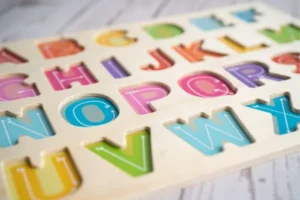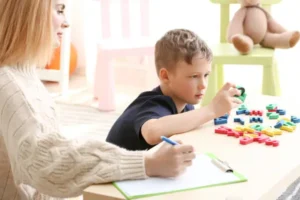Building vocabulary is a crucial part of language development for all children, but it can be particularly challenging for those on the autism spectrum. Many children with autism experience delays in language development, which can impact their ability to communicate and connect with others. However, educational toys offer a fun and interactive way to support vocabulary growth. These toys provide children with opportunities to engage in language-building activities while playing, making learning enjoyable and effective. In this article, we’ll explore how educational toys can help autistic kids expand their vocabulary and enhance communication skills.
The Importance of Vocabulary Development for Autistic Children
Vocabulary development is essential because it lays the foundation for effective communication. For children with autism, building a strong vocabulary can help improve social interactions, self-expression, and understanding of the world around them. Many children with autism face challenges in language acquisition, such as difficulty pronouncing words, understanding social cues, or using language in meaningful ways. Strengthening vocabulary can help address these challenges by increasing word recall, comprehension, and the ability to engage in conversations with others.
How Play Supports Vocabulary Growth
Play is one of the most natural and enjoyable ways for children to learn. It’s a process that encourages exploration, imagination, and creativity—critical components for language development. Through play, children can practice using words, reinforce new vocabulary, and build confidence in communication. Whether it’s sensory play, imaginative role-playing, or interactive games, different types of play offer various ways to help children internalize language. Play-based learning helps reinforce vocabulary by providing real-life contexts where words are used repeatedly in a meaningful way.
Educational Toys: A Key Tool for Vocabulary Building
Educational toys are powerful tools for enhancing language development because they offer interactive and engaging ways for children to practice and reinforce vocabulary. These toys are designed to stimulate different senses, promote social interactions, and encourage verbal and non-verbal communication. When used correctly, educational toys can turn learning into a fun experience, helping children absorb new words and concepts without the pressure of traditional lessons. They can also be adapted to suit a child’s interests, making vocabulary-building more personalized and engaging.
Top Educational Toys for Building Vocabulary in Autistic Children
Here are some great educational toys to help autistic children build their vocabulary in a fun and engaging way:
1. Interactive Robots (e.g., Cozmo, Botley)
These robots encourage verbal communication through commands and interactions. Kids can practice using simple words, phrases, and commands to engage with the robots, helping to improve their vocabulary and social communication skills.
2. Pretend Play Sets (e.g., toy kitchens, doctor kits)
Pretend play sets allow children to act out different scenarios, promoting the use of situational vocabulary. Role-playing as a chef, doctor, or storekeeper encourages children to learn and use words related to everyday tasks, improving their understanding of language in context.
3. Sensory Bins
Sensory bins filled with materials like rice, sand, or water beads can help children describe what they see, feel, and touch. These hands-on activities encourage vocabulary development as children practice using descriptive language (e.g., soft, rough, smooth) and identify objects within the bin.
4. LeapFrog My Pal Violet
This customizable plush toy engages children with songs, phrases, and interactive conversation. Violet can help children practice new words through music and repetition, reinforcing vocabulary in a fun, personalized way.
5. VTech Touch and Learn Activity Desk
This interactive desk offers a variety of educational games that help children identify objects, practice sounds, and learn new words. The colorful buttons and engaging activities make learning fun and multisensory, reinforcing vocabulary growth through play.
6. Storytelling Toys (e.g., Little Story Buddy)
Storytelling toys encourage children to listen, repeat, and create stories. By interacting with these toys, children can practice vocabulary associated with different characters and narratives, strengthening their understanding of word usage in storytelling.
7. Flashcards and Word Games
Flashcards and interactive word games are simple but effective tools for reinforcing vocabulary. These toys encourage children to match words to images or actions, helping them to recognize and recall vocabulary in a playful setting.
Creative Strategies for Using Educational Toys to Build Vocabulary
To make the most of these toys, here are a few creative strategies to maximize vocabulary development:
- Pair Play with Daily Activities: Turn everyday activities into learning moments. For instance, while playing with a toy kitchen, encourage your child to name the ingredients or describe what they’re doing, like “stirring” or “baking.”
- Incorporate Songs and Rhymes: Use musical toys to help reinforce words through rhythm and repetition. Singing songs or rhyming with toys can help children remember new vocabulary while enjoying the music.
- Repetition and Consistency: Children learn through repetition. Make vocabulary-building a consistent part of daily playtime. The more your child hears and uses words, the easier it will be to remember and apply them.
- Encourage Parent-Child Interaction: As a parent or caregiver, take an active role in playtime. Use the toys to model language, ask questions, and guide your child through the activity. This interaction supports language development and builds a stronger connection with your child.
Success Stories and Examples
Many children with autism have shown significant progress in vocabulary development through the use of educational toys. For example, Emma, a 4-year-old, struggled with initiating conversations but improved her vocabulary and social interaction skills by interacting with the Cozmo robot. Similarly, Noah, a 5-year-old, expanded his vocabulary through role-playing with a doctor kit, practicing words like “stethoscope” and “diagnose.” These real-life examples highlight the impact of educational toys on language growth.
Tips for Maximizing Vocabulary Development Through Play
- Observe and Personalize: Pay attention to your child’s preferences. If they love a particular toy or activity, use that as an opportunity to expand their vocabulary in a way that aligns with their interests.
- Be Patient and Celebrate Small Wins: Language development takes time, so celebrate progress, no matter how small. Positive reinforcement can keep your child motivated and engaged.
- Combine Toys with Therapy: Collaborate with speech-language pathologists to align the toys with your child’s specific needs. Therapy-based strategies can further enhance the effectiveness of educational toys.
Conclusion
Building vocabulary through play is an effective and enjoyable way to support language development in children with autism. Educational toys provide opportunities to practice and reinforce new words, helping children develop their communication skills in a fun, interactive way. By using the right toys and adopting creative play strategies, parents can help their children expand their vocabulary and gain confidence in using language. Remember to be patient, consistent, and always celebrate progress as it comes. The journey of language development may be challenging, but with the right tools and support, your child can make remarkable strides.



